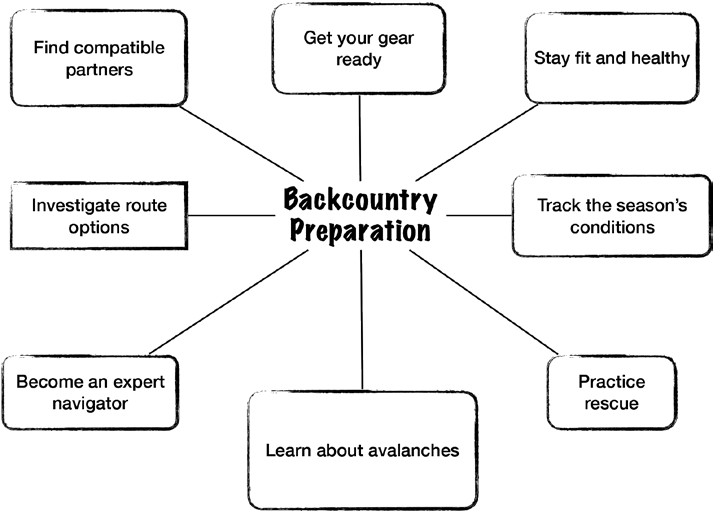How do ski guides prep for the season? What’s a typical ‘locker room’ conversation that happens between guides before they embark on a backcountry trip? Over the next several weeks, we’ll be publishing excerpts from Rob Coppolillo’s The Ski Guide Manual that answer some of those questions. For the rest of those answers, pre-order your copy of the book.

Going into the backcountry requires prep and planning. A checklist, process, or flowchart—however you conceive of it—helps mitigate risk, find the best skiing, and deliver safer, more enjoyable touring. This graphic captures the bird’s-eye view of one process. Chart designed by Colin Zacharias
Backcountry Prep
Our trip plan really begins late summer and early fall, when we revisit our gear, begin working on ski fitness, incorporate new teammates, identify some season goals, and further develop our run atlas. Between your mountain biking, rock climbing, competitive lawn-dart tournaments, a little work, perhaps some parenting, you should find the time to lay the foundation for a fantastic ski-and-ride season in the months leading up to it. When the backcountry finally fills in, you want to be ready, mentally and physically. The easy part is getting the legs and lungs strong enough for the long days, believe it or not. Ask yourself, though: If you’re willing to do your dead lifts, weighted hikes, and plyometrics, are you doing the same work mentally? Seasonal prep acts as gym time for your brain and decision-making skills.
The irony is, we often spend more time researching and buying a new set of skis than we do refining our skills for the upcoming winter. I’m guilty of it too! Be honest with yourself, though. Are you preparing as diligently mentally as you are physically? Is your head game as dialed-in as your new choice in steep skis? Do you practice your decision making? How? When?
Hopefully, after reading this chapter you’ll have some specific, actionable tasks to help your mental game. One of the most enjoyable aspects of backcountry touring is the lifelong progression and learning it involves. I’ll expand the idea of the daily debrief in a later chapter, but as we think about and get ready for the upcoming season, consider a debrief for your previous season(s). What went well last year? What were your successes from last year, or over the course of the year? And then be honest with yourself and your teammates: What could you improve moving into the future? Answer these questions and lay out a workable plan for the winter. These insights should help you identify areas for improvement for the fall.
A “Wicked Environment”
Backcountry touring brings us to stunning landscapes and braves tough weather, but this isn’t the wicked environment researchers describe. Rather, a wicked environment involves any situation in which a decision maker faces multiple variables, each dependent upon the others. It is, by definition, unpredictable, nonlinear, and complex; it offers little to no feedback and, at times, even inaccurate feedback. By this researchers mean on some days the feedback you get isn’t the feedback you ought to get.
Imagine a tour in which you ski thigh-deep untracked snow, lap after lap, under blue skies. You return to the lodge high on the experience, confident in how well you nailed it. What if, though, you got away with the tour simply due to luck? Perhaps the slopes you tore up were waiting to avalanche and you merely missed the “sweet spot” and didn’t trigger one. Your feedback, though, indicated a great day and a rousing success.
The feedback you should’ve gotten, however, was an avalanche and a big scare. Bruce Kay, a longtime avalanche professional, uses the term “wicked environment”; Nobel Prize–winning psychologist Daniel Kahneman uses the term “low-validity environment.” Whichever you prefer, one of the critical criteria for this situation is a lack of feedback or even inaccurate feedback. We end up at the ski lodge brimming with confidence, when we should’ve slunk back quietly, knowing we need to do some serious rethinking about our process. Professionals who study these environments explain that it is possible to make quality, safer decisions in a wicked environment by employing a “repeatable process.” Trip planning is your repeatable process.
Trip planning is merely a method or algorithm by which you anticipate problems so that you can make better, safer decisions in a challenging environment. You then debrief to gain insights from your process and improve (more on the debrief in a subsequent chapter). Keep in mind, all this proper planning will also set you up for better turns! Employing a repeatable process is your best strategy for a long, safer career in the backcountry . . . and getting the goods. This chapter (more accurately, this book) is one blueprint for the process—drawing on guide training and the avalanche industry in the United States and Canada. It is by no means the only one. It is one version but, keep in mind, a version time-tested by mountain guides and avalanche professionals over decades.
The Ski Guide Manual will be available from Falcon Guides on November 1, 2020. Pre-order your copy and stay tuned for the next installment in the excerpt series.
Rob Coppolillo is a mountain guide and writer, based on Vashon Island, in Puget Sound. He’s the author of The Ski Guide Manual.
